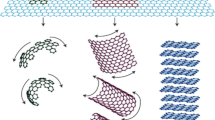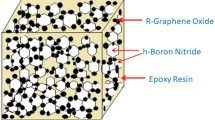Abstract
Molybdenum disulfide (MoS2), a 2D layered material has been recognised as a new paradigm in the area of materials science due to its graphene like structure. Herein, we prepared functionalized MoS2 nanosheets through one-pot hydrothermal technique using cationic surfactant, cetyltrimethylammonium bromide (CTAB). The surfactant functionalized MoS2 (CTAB-MoS2) was subsequently dispersed in epoxy matrix at the loading level of 0.1–0.5 wt% to investigate the reinforcing competence of MoS2 on the mechanical and thermal properties of the composites. Fourier transform infrared spectroscopy, X-ray diffraction and field emission scanning electron microscopy (FE-SEM) were used to characterize the microstructure and morphology of the hydrothermally prepared pristine MoS2 and CTAB-MoS2. Dynamic mechanical and tensile properties were studied to comprehend the effect of functionalized MoS2 on the mechanical properties of the composites. At 0.2 wt% loading, the tensile strength and Young’s modulus was improved by ~23 and 26.7%, respectively, while ~83% improvement in storage modulus was recorded. Thermal stability of all the studied specimens were compared by selecting the temperatures at 10 and 50% weight losses which showed small decrease in onset degradation temperature.














Similar content being viewed by others
References
Rao CNR, Maitra U, Waghmare UV (2014) Extraordinary attributes of 2-dimensional MoS2 nanosheets. Chem Phys Lett 609:172–183
Zhou K, Liu J, Wen P, Hu Y, Gui Z (2014) A noncovalent functionalization approach to improve the dispersibility and properties of polymer/MoS2composites. Appl Surf Sci 316:237–244
Li Y, Yu Y, Huang Y, Nielsen RA, Goddard WA, Li Y, Cao L (2015) Engineering the composition and crystallinity of molybdenum sulfide for high-performance electrocatalytic hydrogen evolution. ACS Catal 5:448–455
Ma G, Peng H, Mu J, Huang H, Zhou XZ, Lei Z (2013) In situ intercalative polymerization of pyrrole in graphene analogue of MoS2 as advanced electrode material in supercapacitor. J Power Sources 229:72–78
Radisavljevic B, Radenovic A, Brivio J, Giacometti V, Kis A (2011) Single-layer MoS2 transistors. Nat Nanotechnol 6:147–150
Li H, Yu K, Fu H, Guo B, Lei X, Zhu Z (2015) MoS2/Graphene hybrid nano flowers with enhanced electrochemical performances as anode for lithium-ion batteries. J Phys Chem C 119:7959–7968
Eksik O, Gao J, Shojaee SA, Thomas A, Chow P, Bartolucci SF, Lucca DA, Koratkar N (2014) Epoxy nanocomposites with two-dimensional transition metal dichalcogenide additives. ACS Nano 8:5282–5289
Wang X, Kalali EN, Wang DY (2015) An in situ polymerization approach for functionalized MoS2/nylon-6 nanocomposites with enhanced mechanical properties and thermal stability. J Mater Chem A 3:24112–24120
Zhou K, Jiang S, Bao C, Song L, Wang B, Tang G, Hu Y, Gui Z (2012) Preparation of poly(vinyl alcohol) nanocomposites with molybdenum disulfide(MoS2): structural characteristics and markedly enhanced properties. RSC Adv 2:11695–11703
Zhou K, Jiang S, Shi Y, Liu J, Wang B, Hu Y, Gui Z (2014) Multigram-scale fabrication of organic modified MoS2 nanosheets dispersed in polystyrene with improved thermal stability, fire resistance, and smoke suppression properties. RSC Adv 4:40170–40180
Wang X, Xing W, Feng X, Yu B, Song L, Yeoh GH, Hu Y (2016) Enhanced mechanical and barrier properties of polyurethane nanocomposite films with randomly distributed molybdenum disulfide nanosheets. Compos Sci Technol 127:142–148
Castellanos-Gomez A, Poot M, Steele GA, van der Zant HSJ, Agrait N, Rubio-Bollinger G (2012) Elastic properties of freely suspended MoS2 nanosheets. Adv Mater 24:772–775
Zhou K, Liu J, Wang B, Zhang Q, Shi Y, Jiang S, Hu Y, Gui Z (2014) Facile preparation of poly (methylmethacrylate)/MoS2 nanocomposites via in situ emulsion polymerization. Mater Lett 126:159–161
Feng X, Wen P, Cheng Y, Liua L, Tai Q, Hu Y, Meow Liew K (2016) Defect-free MoS2 nanosheets: advanced nanofillers for polymer nanocomposites. Compos A 81:61–68
Huang G, Chen T, Chen W, Wang Z, Chang K, Ma L, Huang F, Chen D, Lee JY (2013) Graphene-like MoS2/graphene composites: cationic surfactant-assisted hydrothermal synthesis and electrochemical reversible storage of lithium. Small 9:3693–3703
Zhou K, Liu J, Zeng W, Hu Y, Gui Z (2015) In situ synthesis, morphology, and fundamental properties of polymer/MoS2 nanocomposites. Compos Sci Technol 107:120–128
Chang K, Chen W (2011) L-Cysteine-assisted synthesis of layered MoS2/graphene composites with excellent electrochemical performances for lithium ion batteries. ACS Nano 5:4720–4728
Liang KS, Chianelli RR, Chien FZ, Moss SC (1986) Structure of poorly crystalline MoS2—a modeling study. J Non Cryst Solids 79:251–273
Tang LC, Wan YJ, Yan D, Pei YB, Zhao L, Li YB, Wu LB, Jiang JX, Lai GQ (2013) The effect of graphene dispersion on the mechanical properties of graphene/epoxy composites. Carbon 60:16–27
Wana YJ, Tang LC, Yan D, Zhao L, Li YB, Wu LB, Jiang JX, Lai GQ (2013) Improved dispersion and interface in the graphene/epoxy composites via a facile surfactant-assisted process. Compos Sci Technol 82:60–68
Ganguli S, Roy AK, Anderson DP (2008) Improved thermal conductivity for chemically functionalized exfoliated graphite/epoxy composites. Carbon 46:806–817
Jia J, Sun X, Lin X, Shen X, Mai YW, Kim JK (2014) Exceptional electrical conductivity and fracture resistance of 3D interconnected graphene foam/epoxy composites. ACS Nano 8:5774–5783
Acknowledgement
Authors are thankful to the Director of CSIR-CMERI. Authors are also thankful to Department of Science and Technology, New Delhi, India for the financial supports (GAP041212) and Council of Scientific and Industrial Research, New Delhi, India for funding MEGA Institutional Project (ESC0112/RP-II).
Author information
Authors and Affiliations
Corresponding authors
Rights and permissions
About this article
Cite this article
Chhetri, S., Adak, N.C., Samanta, P. et al. Investigation of mechanical and thermal properties of the cetyltrimethylammonium bromide functionalized molybdenum disulfide (MoS2)/epoxy composites. Polym. Bull. 75, 327–343 (2018). https://doi.org/10.1007/s00289-017-2037-8
Received:
Revised:
Accepted:
Published:
Issue Date:
DOI: https://doi.org/10.1007/s00289-017-2037-8




